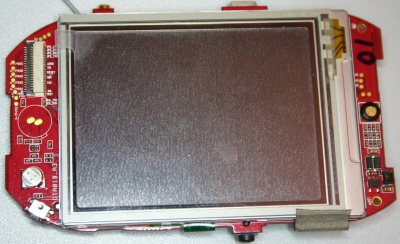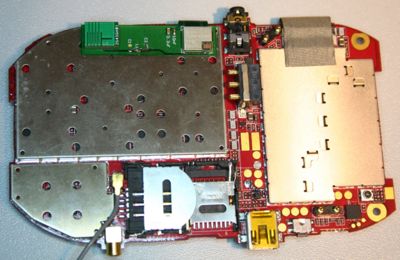Neo1973 Hardware/zh cn
From Openmoko
(→Main components) |
|||
| Line 9: | Line 9: | ||
* 184 +/- 5 g (6.5 ounces) | * 184 +/- 5 g (6.5 ounces) | ||
| − | == | + | == 主要元件 == |
| − | === | + | === 处理器 === |
The main Processor (CPU) of the Neo1973 is a Samsung S3C2410AL-26 (Capable of running up to 266 MHz) | The main Processor (CPU) of the Neo1973 is a Samsung S3C2410AL-26 (Capable of running up to 266 MHz) | ||
| Line 18: | Line 18: | ||
* GPIO Assignments: https://svn.openmoko.org/trunk/doc/hardware/GTA01Bv3/gpio.txt | * GPIO Assignments: https://svn.openmoko.org/trunk/doc/hardware/GTA01Bv3/gpio.txt | ||
| − | === | + | === 闪存 === |
| − | + | 与S3C2410 NAND控制器相连的64MB Samsung NAND闪存(K9F1208U0B)。 | |
* Product Homepage: [http://www.samsung.com/products/semiconductor/NANDFlash/SLC_SmallBlock/512Mbit/K9F1208U0B/K9F1208U0B.htm K9F1208U0B.htm] | * Product Homepage: [http://www.samsung.com/products/semiconductor/NANDFlash/SLC_SmallBlock/512Mbit/K9F1208U0B/K9F1208U0B.htm K9F1208U0B.htm] | ||
| Line 29: | Line 29: | ||
We only use free software, no proprietary flash file systems. For a full description of how it is used, see [[NAND bad blocks]] | We only use free software, no proprietary flash file systems. For a full description of how it is used, see [[NAND bad blocks]] | ||
| − | === | + | === 内存 === |
128MB SDRAM (2x Samsung K4M511633C) attached to S3C2410 SDRAM controller | 128MB SDRAM (2x Samsung K4M511633C) attached to S3C2410 SDRAM controller | ||
* Product Homepage: [http://www.samsung.com/Products/Semiconductor/MobileSDRAM/MobileSDRSDRAM/512Mbit/K4M511633C/K4M511633C.htm K4M511633C.htm] | * Product Homepage: [http://www.samsung.com/Products/Semiconductor/MobileSDRAM/MobileSDRSDRAM/512Mbit/K4M511633C/K4M511633C.htm K4M511633C.htm] | ||
| Line 64: | Line 64: | ||
This will not have a working driver till at least mid April. | This will not have a working driver till at least mid April. | ||
| − | === | + | === microSD卡 === |
The Neo1973 has one microSD aka Transflash slot. | The Neo1973 has one microSD aka Transflash slot. | ||
It should support SDHC, but this has not been tested. If this works, cards >2G should work with no problems. | It should support SDHC, but this has not been tested. If this works, cards >2G should work with no problems. | ||
| Line 73: | Line 73: | ||
* Specifications: [http://www.sdcard.org/confirm/confirm_memorycard.aspx SD Simplified Specification], [http://www.mmca.org/compliance/buy_spec/AN_MMCA050419.pdf MMC (partial)], [http://www.sandisk.com/Assets/File/OEM/Manuals/manual-rs-mmcv1.0.pdf MMC (product manual)] | * Specifications: [http://www.sdcard.org/confirm/confirm_memorycard.aspx SD Simplified Specification], [http://www.mmca.org/compliance/buy_spec/AN_MMCA050419.pdf MMC (partial)], [http://www.sandisk.com/Assets/File/OEM/Manuals/manual-rs-mmcv1.0.pdf MMC (product manual)] | ||
| − | === | + | === LCD显示模块 === |
This is a 2.8" 480x640 toppoly (tpo) TD028TTEC1 module, using a Toshiba JBT6K74 TFT LCD Driver Chipset. | This is a 2.8" 480x640 toppoly (tpo) TD028TTEC1 module, using a Toshiba JBT6K74 TFT LCD Driver Chipset. | ||
* Homepage: [http://www.tpo.biz/ENG/business-eng/Activer-Matrix-VGA.htm Activer-Matrix-VGA.htm] | * Homepage: [http://www.tpo.biz/ENG/business-eng/Activer-Matrix-VGA.htm Activer-Matrix-VGA.htm] | ||
| Line 80: | Line 80: | ||
* Connected to: S3C2410 Display Controller | * Connected to: S3C2410 Display Controller | ||
| − | ==== | + | ==== 触摸屏 ==== |
* Connected to: S3C2410 TS controller | * Connected to: S3C2410 TS controller | ||
* Driver: https://svn.openmoko.org/trunk/src/target/kernel/patches/s3c2410_touchscreen.patch | * Driver: https://svn.openmoko.org/trunk/src/target/kernel/patches/s3c2410_touchscreen.patch | ||
| Line 88: | Line 88: | ||
Seemingly identical to [http://cgi.ebay.com/4in1-PDA-Stylus-LED-Light-Torch-Laser-Pointer-Pen-h7_W0QQitemZ280089656134QQihZ018QQcategoryZ48677QQrdZ1QQcmdZViewItem this one on ebay] | Seemingly identical to [http://cgi.ebay.com/4in1-PDA-Stylus-LED-Light-Torch-Laser-Pointer-Pen-h7_W0QQitemZ280089656134QQihZ018QQcategoryZ48677QQrdZ1QQcmdZViewItem this one on ebay] | ||
| − | === | + | === 蓝牙 === |
Delta DFBM-CS320 Class2 Module, using CSR BlueCore4 | Delta DFBM-CS320 Class2 Module, using CSR BlueCore4 | ||
| Line 145: | Line 145: | ||
* Driver Source: https://svn.openmoko.org/trunk/src/target/kernel/patches/gta01-pcf50606.patch | * Driver Source: https://svn.openmoko.org/trunk/src/target/kernel/patches/gta01-pcf50606.patch | ||
| − | === | + | === 电池 === |
The [[Neo1973 Battery]] is compatible with a Nokia BL5C battery. | The [[Neo1973 Battery]] is compatible with a Nokia BL5C battery. | ||
According to [http://lists.openmoko.org/pipermail/community/2007-February/003758.html this] post on the mailinglist. | According to [http://lists.openmoko.org/pipermail/community/2007-February/003758.html this] post on the mailinglist. | ||
Revision as of 14:26, 8 March 2007
Contents
|
User experiences of Phase 0 hardware
Physical Dimensions
- 120.7 x 62 x 18.5 mm (4.75 x 2.44 x 0.728 inch)
- 184 +/- 5 g (6.5 ounces)
主要元件
处理器
The main Processor (CPU) of the Neo1973 is a Samsung S3C2410AL-26 (Capable of running up to 266 MHz)
- Product Homepage: S3C2410.htm
- User Manual: 2410UserManual.pdf
- BSDL File: S3C2410_BGA_BSDLJTAGFILE.bsd
- GPIO Assignments: https://svn.openmoko.org/trunk/doc/hardware/GTA01Bv3/gpio.txt
闪存
与S3C2410 NAND控制器相连的64MB Samsung NAND闪存(K9F1208U0B)。
- Product Homepage: K9F1208U0B.htm
- Data Sheet: ds_k9f1208x0b_rev03.pdf
- Connected to: S3C2410 NAND controller
This is the only flash memory in the device. The S3C2410 boots directly from nand, using the S3C2410 Steppingstone.
We only use free software, no proprietary flash file systems. For a full description of how it is used, see NAND bad blocks
内存
128MB SDRAM (2x Samsung K4M511633C) attached to S3C2410 SDRAM controller
- Product Homepage: K4M511633C.htm
- Data Sheet: ds_k4m511633c.pdf
- Connected to: S3C2410
GSM/GPRS
The GSM/GPRS modem is Texas Instruments Calypso based.
- Connected to: S3C2410 UART1 (full-uart, RxD, TxD, CTS, RTS), /dev/ttySAC0 in userspace
- PM Driver: https://svn.openmoko.org/trunk/src/target/kernel/patches/gta01-power_control.patch
- Accessible GSM/GPRS antenna jack (if battery cover is removed)
CALYPSO digital baseband
Unfortunately we cannot provide many details on the GSM chipset due to very tight NDAs. However, this is not neccessarily required, since it interfaces using a standard UART serial line with the S3C2410. On that interface, GSM 07.05, GSM 07.10 and other standardized protocols are used.
-- xkr47: Could we at least know the GPRS capabilitiy class and the GPRS multislot class ?
TWL3014 analog baseband
Product Homepage: TWL3014
TRF6151 RF Transceiver
Product Homepage: TRF6151
AGPS
Hammerhead AGPS from Global Locate.
- Product Homepage: Hammerhead
- Connected to: S3C2410 UART2 (full-uart, RxD, TxD, CTS, RTS) /dev/ttySAC1 in userspace
- Driver: Implemented as plugin for the gpsd daemon (gpsd)
- PM Driver: https://svn.openmoko.org/trunk/src/target/kernel/patches/gta01-power_control.patch
- Externally-accessible GPS antenna connector (specify the kind: SMB, SMA, ..?)
This will not have a working driver till at least mid April.
microSD卡
The Neo1973 has one microSD aka Transflash slot. It should support SDHC, but this has not been tested. If this works, cards >2G should work with no problems. As there are no microSD cards over 2G at the moment, it hasn't been tested.
- Connected to: S3C2410 MMC/SD controller
- Driver: https://svn.openmoko.org/trunk/src/target/kernel/patches/s3c_mci.patch
- Supported microSD cards
- Specifications: SD Simplified Specification, MMC (partial), MMC (product manual)
LCD显示模块
This is a 2.8" 480x640 toppoly (tpo) TD028TTEC1 module, using a Toshiba JBT6K74 TFT LCD Driver Chipset.
- Homepage: Activer-Matrix-VGA.htm
- Driver: https://svn.openmoko.org/trunk/src/target/kernel/patches/gta01-jbt6k74.patch
- Backlight Driver: https://svn.openmoko.org/trunk/src/target/kernel/patches/gta01-backlight.patch
- Connected to: S3C2410 Display Controller
触摸屏
- Connected to: S3C2410 TS controller
- Driver: https://svn.openmoko.org/trunk/src/target/kernel/patches/s3c2410_touchscreen.patch
Stylus
Seemingly identical to this one on ebay
蓝牙
Delta DFBM-CS320 Class2 Module, using CSR BlueCore4
- Data Sheet: 2.DFBM-CS320.pdf
- CSR Data Sheet: CS-101564-DSP10 BlueCore4-ROM Product Data Sheet.pdf
- Driver: Stock Linux Kernel BlueZ
- Connected to: S3C2410 USB Host controller (OHCI)
- PM Driver: https://svn.openmoko.org/trunk/src/target/kernel/patches/gta01-power_control.patch
Vibrator
- Driver: https://svn.openmoko.org/trunk/src/target/kernel/patches/gta01-vibrator.patch
- Connected to: S3C2410 GPIO
USB Host
The USB Host controller is inside the S3C2410
- Driver: Stock Linux kernel ohci_hcd
USB Device
The USB Device controller is inside the S3C2410
- Driver: https://svn.openmoko.org/trunk/src/target/kernel/patches/s3c2410_udc.patch
- Please see USB Product IDs on information about which Vendor/Product IDs we use
- 1200mAh lithium battery charges when connected to powered host.
- Mini-AB connector similar to this one.
Audio
See also: Neo1973 Audio Subsystem
Wolfson Codec
There's a WM8753 Wolfson Microelectronics CODEC (This is not a 'smart' codec that can interpret MP3/... it is a simple dumb 'sound card'.
- Product Homepage: http://www.wolfsonmicro.com/products/WM8753/
- Data Sheet: WM8753.pdf
- Connected to: S3C2410 IIS interface (PCM data), S3C2410 I2C (Control)
- Driver: https://svn.openmoko.org/trunk/src/target/kernel/patches/asoc.patch
Stereo Amplifier
There's a National Semiconductor LM4857 Stereo Amplifier at the analog audio output of the WM8753
- Product Homepage: LM4857.html
- Data Sheet: LM4857.pdf
- Connects to: S3C2410 I2C (Control)
Analog wired Headset
There's a four-ring 2.5mm stereo jack which provides connectivity to old-fashioned wired headsets.
The headsets used by Motorola smartphones (A780,A1200, ...) and the V-360 have a compatible configuration.
Bluetooth Headset
This one is wired via PCM bus from the CSR Bluetooth chip to the Wolfson codec.
Power Management
A Philips PCF50606 is used for power management.
- Data Sheet: PCF50606/605
- User Manual: pcf50606.pdf
- Connected to: S3C2410 via I2C, client address is 0x08.
- Driver Source: https://svn.openmoko.org/trunk/src/target/kernel/patches/gta01-pcf50606.patch
电池
The Neo1973 Battery is compatible with a Nokia BL5C battery. According to this post on the mailinglist. Photo of the battery inside the Neo1973.
Buttons
The Neo1973 features two buttons:
- A Power Button
- A "911" button
History
GTA01
This is the most simple, non-bluetooth version of the prototype.
GTA01v3
First generation of prototypes that was given to internal OpenMoko software developers.
Unfortunately not useful at all due to non-working touchscreen.
- ATAG_REVISION: 0x0000130
GTA01v4
Second generation of prototypes that was given to Harald + Mickey.
Unfortunately still not useful due to half-working touchscreen.
- ATAG_REVISION: 0x00000140
GTA01B
This is the bluetooth-enabled fork of GTA01
GTA01Bv2
This is the first produced version of the bluetooth-enabled version.
- ATAG_REVISION: 0x00000220
GTA01Bv3
This is the second produced version of the bluetooth-enabled version. It contains mainly GPS-related fixes.
- ATAG_REVISION: 0x00000230
This is the version that is shipped in Phase 0
GTA01Bv3 Errata
PMU unable to resume from suspend
Due to use of wrong GPIO/EINT pin, the PMU cannot wake-up the phone after suspend. This means, specifically, the following events can not bring the phone back from suspend-to-ram:
- PMU RTC Alarm
- Power button press
- Charger events (charger insertion/removal/error)
- Low battery
Stand-by time extremely low
This is due to a design bug resulting in at least 30mA additional standby current, since we cannot properly switch off the power supply to the S3C2410 PLL's. There is nothing we can do to change this with post-production fixes. GTA01Bv4 will address this issue.
GSM doesn't resume phone from suspend
The GSM modem currently doesn't signalize a wakeup interrupt to the S3C2410 in case there's some noteworthy event, such as incoming call, loss of network, incoming SMS or the like.
This is a serious issue, but can be fixed with a GSM Modem Firmware update.
GSM Sidetone too loud
The local feedback sidetone (see [1]) is too loud. This will be addressed in a GSM firmware update
Bad block
Due to an error in the production process, the factory-programmed NAND bad block information has been lost. This means that some blocks in the flash will wear out rapidly, which might become as bad as rendering the device unusable.
GTA01Bv4
This is the version that will be shipped in Phase 1
Changes from GTA01Bv3
- Fix all Errata items from GTA01Bv3
- Add I2C, SPI and one irq and wakeup capable GPIO pin to debug port plus have test pads for all these signals (for soldering wires directly on the pcb)
- Fix a number of production related details and minor hardware details that are not user-visible
Distinguishing hardware revisions
Inside the Bootloader
Every hardware revision has its own u-boot image type. Thus, the bootloader has the revision hard-coded. The hardware revision is passed on to the kernel via the ATAG mechanism (ATAG_REVISION)
Inside the Kernel
The kernel receives the ATAG_REVISION during bootup, and saves its contents in the "system_rev" global variable.
From Userspace
The kernel exports the system_rev variable in /proc/cpuinfo as "Revision :" line.
| Languages: |
English • العربية • Български • Česky • Dansk • Deutsch • Esperanto • Eesti • Español • فارسی • Suomi • Français • עברית • Magyar • Italiano • 한국어 • Nederlands • Norsk (bokmål) • Polski • Português • Română • Русский • Svenska • Slovenčina • Українська • 中文(中国大陆) • 中文(台灣) • Euskara • Català |


